- By Dan Veaner
- Around Town
 Print
Print 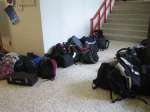 The Lansing school capital project committees are building a project from the ground up with the hope that a project built by community members will have the support of the community when it comes to a vote in December. In order to help committee members understand the needs in the High School and Middle School Principals Michelle Stone and John Gizzi conducted tours for committee members. The principals told the committees that a tour during school hours would tell the story best, but they scheduled a second tour after-hours to accommodate those who could not leave work during the day.
The Lansing school capital project committees are building a project from the ground up with the hope that a project built by community members will have the support of the community when it comes to a vote in December. In order to help committee members understand the needs in the High School and Middle School Principals Michelle Stone and John Gizzi conducted tours for committee members. The principals told the committees that a tour during school hours would tell the story best, but they scheduled a second tour after-hours to accommodate those who could not leave work during the day.| Opinion Alert! In the interests of full disclosure, I am not actually on the facilities committee, and as a district resident with two children in the school system I am torn between two motivations: I want everything for Lansing kids and I think school taxes are too high. As I listened to the High School and Middle School principals on this tour I could see for myself what the issues are. I didn't agree with everything they told me, though I understand their point of view. Most of what I saw didn't need a narration. I could see, hear and smell the problems and needs, especially in the High School. My opinion is that we do need a capital project, and if we do nothing else we must make sure our kids have an adequate, safe place to learn. In a perfect world we'd get everything including the controversial High School Auditorium (which appears to be entirely off the table this time around). But its not a perfect world. The facilities committee will have to craft a project that both addresses the district's needs and that the community can support. |
Fewer than a third of those responsible for building the project attended a tour. Only two attended the school-hours tour including this reporter (I am not on either of the committees, but am attending their meetings to report on their ongoing activities). So on Wednesdays the principals walked Maureen Bell and me around their schools. This is what we saw:
Scheduling and Classrooms
We began in Michelle Stone's office in the High School where she explained how she schedules rooms in the building. "I'm going to have a significant jump next year in an already cramped situation," she said. "This next year I have 81 seniors leaving and about 118 freshmen coming in. You can do the math."
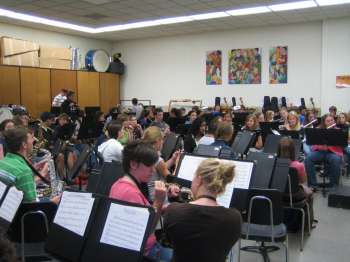
The band room is wall-to-wall students
Stone has already used creative scheduling to accomodate the High School programs. "Music was clumped at the end of the day block," she says. "Because there is such a high enrollment in the music program it was difficult to schedule anything else in that block. I created an overlapping chunk in the middle of the day." Periods 1-4 and 10 and 11 are 41 minutes long. 5 through 9 alternate between 31 minutes and 10. This allows Stone to create a 31 minute lunch period so she can optimize classroom time. Kids can choose to be in more than one ensemble, but to do that they choose a ten minute lunch.
Stone noted that the national standard for room usage is 80%. She explained that her schedule allows scheduling over eight periods (classes can't be scheduled during lunch because there is not enough time). 19 rooms are scheduled for eight periods and 10 more for seven. The cafeteria and library are each scheduled for 4+ periods and 2+ periods are in the Middle School shop. Taking the shop out of the equation, Stone's rooms are scheduled an average 7.42 periods per day, or 92.75% of the day, well above the recommended level. Hallways are also being used and some programs are in rooms the size of a closet. "We are optimizing every square inch of this building to a frightening degree," Stone says. She is very concerned about next year's schedule with increased enrollment in the building.
Acoustics and Sound
Sound is a problem. Much of the High School was constructed as open spaces. Many classrooms have temporary walls that are thin enough that you can hear the classes on either side of you and activity in the hallways. The theory at the time was that the space was flexible, and classrooms could be reconfigured as needed. This was never actually done.
Science Rooms
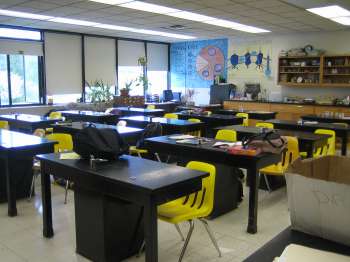
Gas jets are on these tables that double for experiments and desks
Stone explained that science rooms need two areas, a classroom space and a laboratory space. One of the rooms is currently split that way, but others just have lab tables. The problem is that kids sitting at a table with a gas jet pointed at their books and papers is a safety hazard. She says that it is natural for them to fidget, and that includes playing with the gas spigot. Walls could be knocked out to create the classroom/laboratory rooms that are needed for science, but that will mean building some new classrooms to replace the ones lost from expanding them.
Music and Art Space
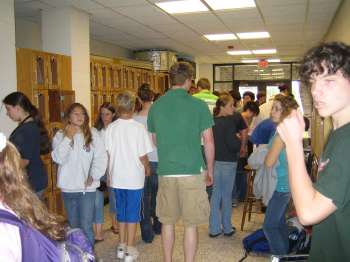
This is the hall outside the music rooms
The hall pictured here also doubles as a practice room.
Stone took us to the music hallway just as a new period began. As kids jammed into the band and chorus rooms, the hall was wall to wall chaos as they got instruments out of cases and tried to get to class in time. They left piles of back packs in the hall so that it was almost impassable. Chairs and music stands are so jammed into the band room that you have to walk sideways to get to your seat. They keep removing built-in desks in the tiered chorus room to make space for the expanding number of kids who want to be in that program.
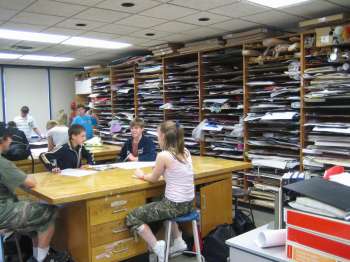
Too much storage, not enough ventilation in the HS art room
The art room reminded me of those old ladies you hear about who have 20 cats, have saved every issue of the newspaper since 1904 and are killed by a stack of them toppling over. Students vie for space with storage, and projects appear to be produced in barely controlled chaos. There is no ventilation, a problem because of the chemicals used in creating art as well as the chlorine smell that comes up from the pool. The room is shared by two art teachers who recently begged the Board of Education for .2 of a position to try to meet the high demand for classes that they cannot service at current staffing levels.
Locker Rooms
Part of the failed capital project that looks like it won't make it into this new version is construction of new locker rooms. Stone noted that the pool is used by many constituencies in Lansing, including Middle and Elementary schoolers, seniors and the Town Recreation Department programs. The pool is in use year 'round, and the current locker rooms are not handicapped accessible. That causes a problem with access to the building, since a side door must be used for that access.
She worries that adults are sharing the same locker room with Kindergartners, and that new locker rooms could not only solve the accessibility problem, but separate the populations of pool users appropriately.
Middle School
We walked over to the Middle School where Principal John Gizzi met us. The Middle School is in less urgent need than the High School is, with plenty of room for the expected enrollment, and core classroom space more than adequate. Gizzy says, "We don't have the space issues, but we have programmatic issues." He explains that the arrangement of some of the rooms he has needs reconfiguring to best serve programs.
Gizzi says the key issues in the Middle School are storage, the safety of windows and wiring and infrastructure for technology. By this he means Ethernet cables and the equipment needed to serve computers and other important technologies to keep Lansing kids competitive in the modern world.
He did identify three key areas that he feels need attention. The first could be fixed simply. Because there is no handicap access in the main entrance, the North entrance must be kept open, a security problem because it is far from the office or any organized supervision. A front office reconfiguration for all three schools was in the last version of the capital project to provide security and control access by having one entrance visible to front office staff. The other two areas are the art and music wing and the technology building.
Art and Music
There were no music classes in the art and music wing when we visited, so it was hard to imagine the big chorus and band rooms being over crowded. However, when he showed pictures to the facilities committee a few days later the message was clear. Gizzi says that there are 110 kids in the biggest chorus and 75 in the biggest band. That is a lot of kids, cases and instruments. He noted that when you are dealing with instrument cases and the fact that these rooms double as storage rooms that they fill up. He pointed out several closets in the hallway used for art, music and theater storage as well as a temporary storage unit behind the building.
Band teacher Gail Hughes told us that when the auditorium is being used for an assembly or classes that she simply can't rehearse the band, because the sound carries through the backstage wall. We visited an art class in progress. While crowded with various projects, students and storage it was not nearly as alarming as the High School art room, though the clutter could be dangerous.
Tech Building
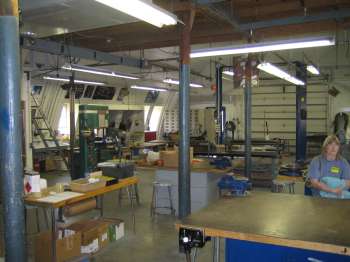
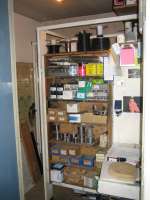 Technology teacher Steve Reukauf showed us the technology building, a large Quonset hut in the parking lot behind the school. The minute you walk into this building you start worrying. Power tools are old and the building itself is held up by wooden beams that are not entirely attached to the floor. A large attic space looms over the main workshop. The girls bathroom is used for storage as well as the attic. Reukauf has to climb up to get materials and equipment, which means leaving kids unsupervised.
Technology teacher Steve Reukauf showed us the technology building, a large Quonset hut in the parking lot behind the school. The minute you walk into this building you start worrying. Power tools are old and the building itself is held up by wooden beams that are not entirely attached to the floor. A large attic space looms over the main workshop. The girls bathroom is used for storage as well as the attic. Reukauf has to climb up to get materials and equipment, which means leaving kids unsupervised.He noted that being alone in the building is a security hazard for kids and for him -- if something happened to him between classes it could take a long time to find him because there isn't typically other staff in the building. He was concerned that kids walk across the parking lot, in winter without coats, and that the concrete floor is slippery, an especial hazard among the power tools. He demonstrated that some of the tools do not turn off with the emergency shutoff switch, and went through a litany of issues too numerous to list here.
Conclusion
It is clear from these tours that the High School is in most need of renovations as well as additions. Stone uses every inch of her building more than 90% of the day. Both schools put students in rooms the size of closets for some classes and programs. We visited at least three Middle School rooms that have been converted from bathrooms. You can still see the tiles.
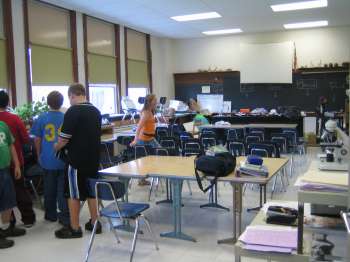
Lab space is pushed to the side in Middle School science
Gizzi noted that tech, art and music are part of State mandates for education. "I've got to think that all those variables put together create these (good) kids," he says. Possibly the most pressing physical need that impacts Middle School programs is the technological infrastructure.
The High School is the poster child for capital project need. Over crowding already inadequate space and facing increasing enrollment, some areas are just plain dangerous. While the music and art rooms are particularly scary, the school needs adequate and safe space for the basics as well, with safe science rooms a particular priority.
There has been a lot of talk in the facilities committees between "needs" and "wants." There is certainly room for interpretation in many of the areas we saw. However it is alarming that so few committee members took their time to see for themselves. That is a pretty vocal committee, and one of the complaints has been that it doesn't have enough facts to craft a capital project. Touring the schools is a good way to begin gathering them.
----
v2i20



